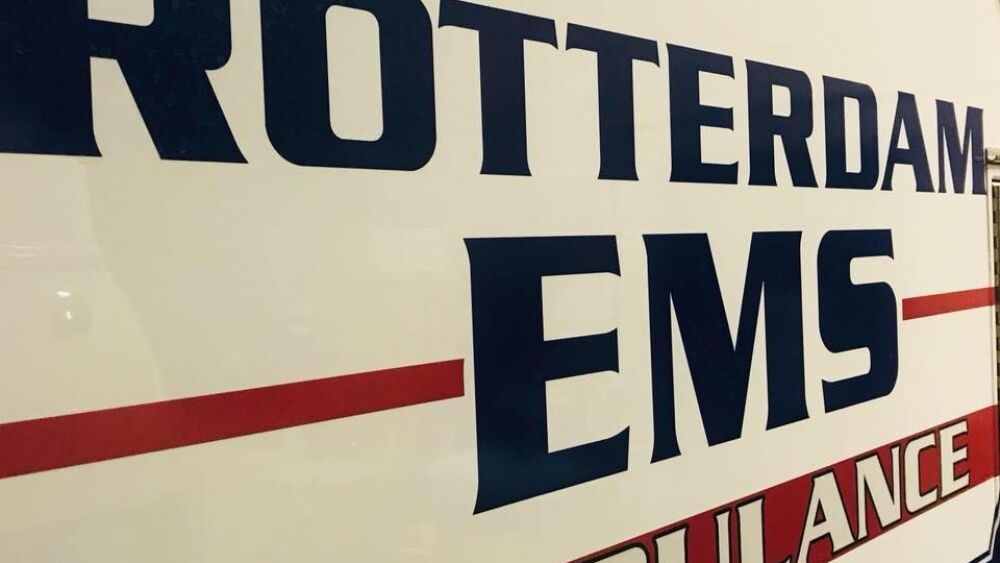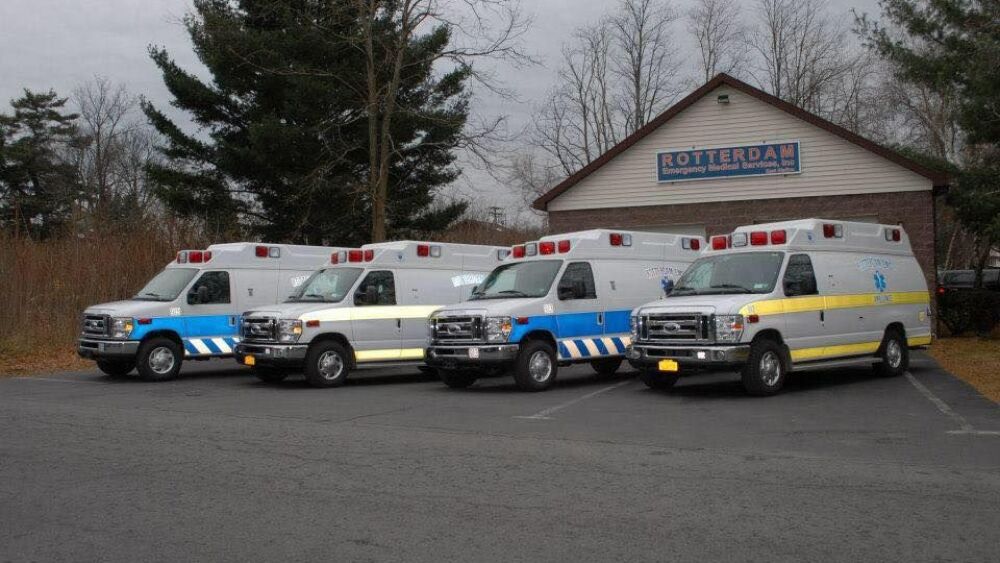By Chad Arnold
The Daily Gazette
ROTTERDAM, N.Y. — Following more than a decade without town funding, the Rotterdam Emergency Medical Services squad is on the verge of financial collapse, prompting concerns about disrupting an emergency response system that has faced increased strain in recent years.
Dean Romano, director of Rotterdam EMS, or REMS, said without town support, the 50-person squad that responds to around 4,000 calls annually will be forced to curtail services or cease operations entirely by the end of next year. He’s hoping the town will allocate the struggling service $400,000 as part of its 2023 budget and establish a special tax district to fund the service permanently beginning in 2024.
“I think in late 2023 it’s going to become a major crisis,” Romano said. “We will have depleted our reserves, and at that point, we’ll be reducing services or whatever we have to do to just sustain the operation.”
Financial struggles are nothing new for REMS, which has a yearly operating budget of $1.7 million and can be traced back to a more than the decade-old decision that saw town officials opt to no longer fund the service. The decision sparked a fierce debate about the future of ambulance services in town that ultimately saw REMS continue to operate on a fee-for-service basis.
But Romano said the model is no longer sustainable due to fluctuating insurance reimbursement rates and rising medical supply costs. He is pushing for the creation of a special tax district to sustain the service — a proposal that voters have rejected once before. REMS’ financial straits will likely renew the years-long debate about how to provide ambulance service in the town and questions about whether the town should contract with an outside service, like Mohawk Ambulance Service, to bolster services.
Romano said additional revenue that would be generated through the tax district — which he projected would raise between $600,000 and $700,000 — would allow REMS to make long-needed capital improvements at its two facilities, offer a more competitive wage to attract new workers and purchase necessary equipment, including new ambulances, and will ultimately secure the future of reliable ambulance service in town.
REMS currently maintains a fleet of seven vehicles, including five ambulances, and operates two crews around the clock at a combined cost of $1 million annually, Romano said.
But issues in recruitment have forced the operation to raise rates, and rising medical supply costs have forced the organization to dip into its reserves, threatening its financial future, Romano said.
He added that the organization has sought to reduce spending and pursue other funding avenues, including a $1.1 million state grant REMS received earlier to pay for capital improvements. But the money, Romano said, will not cover the full scope of work that has been pushed off since the ambulance service lost town funding.
Essential equipment is also coming to the end of life, according to Romano, who said three of the squad’s ambulances will have reached their 10-year lifespan by next year and would need to be replaced — an expense the ambulance squad can not afford without additional funding.
“We’ve done everything we possibly can do to be lean to keep the system moving in the right direction,” Romano said. “But at this point, it’s the town’s turn to decide do you really want us or not? Because we can’t afford to keep doing it for free.”
Read next
N.Y. EMS agency to get $1.1M in state funding
Rotterdam EMS plans to replace three of its five ambulances and update one of its two stations
But establishing a special tax district is a months-long process that may not result in approval. Officials, meanwhile, worry about the future of EMS service in Schenectady County if REMS were to disappear.
Under state law, to create a taxing district the town would have to complete a map planning study that would examine the extent of the district, scope of services and tax rate, and hold a public hearing on the proposal.
The Town Board would then have the option of passing a resolution to either spike the proposal or move forward with a permissive referendum, which would allow residents to petition to hold a town vote on establishing a taxing district.
If a referendum is not triggered, lawmakers can approve the district with permission from the state Comptroller’s Office, which would review the proposal and make a recommendation.
A similar proposal was put before residents in 2010 and rejected by a 2-to-1 ratio. It’s unclear if the Town Board would move forward with the idea or find an additional funding source or contract with a different organization entirely.
Town Supervisor Mollie Collins said she has met with Romano to discuss the issue, but noted she believes residents should be responsible for deciding to form a tax district.
“This is going to be on their tax bill for the rest of the time they live in Rotterdam,” she said.
EMS tax districts have grown increasingly popular, particularly in rural areas. But districts have been formed in suburban areas as well, including in Clifton Park, Malta and Ballston in recent years, according to data provided by the state Comptroller’s Office.
Neighboring municipalities also fund ambulance services through their general fund, including the towns of Colonie and Guilderland. Rotterdam is currently working to establish its 2023 operating budget, which does not include funding for ambulance services.
Failing to fund the service would have implications that extend beyond Rotterdam’s borders, said Romano, who noted REMS is part of Schenectady County’s mutual aid plan and routinely provides services in Schenectady, Duanesburg and Princetown.
“Rotterdam EMS is part of a much larger system, very complex, very intricate and very delicate system,” Romano said. “To let one resource go would put an incredible strain on the rest of the resources and the balance. It won’t take much to push that balance completely off kilter.”
Schenectady Fire Chief Don Mareno agreed, noting REMS routinely provides mutual aid in the city and is part of a system that has been strained in recent years due issues with recruitment and increased hospital wait times.
“If they [REMS] do pull away, it will cause additional stress on an already stressed situation,” he said.
But Jim McPartlon, president of Mohawk Ambulance Service, disagreed, saying there are “lots of ambulances” in the area that can fill the gap. Mohawk Ambulance Services competed for a contract to provide ambulance service in town in 2013, but the town ultimately decided to continue with REMS.
Mohawk Ambulance Service currently provides transportation services throughout Schenectady, Glenville and Scotia, responding to around 20,000 calls in Schenectady County annually and is paid on a fee-for-service basis. The organization, McPartlon said, would be able to fill the gap in Rotterdam should REMS be forced to reduce services.
The company has recently bolstered its recruitment efforts and tweaked its EMT training, offering students in the six-week course a weekly stipend that is forgiven following one year of service with the independent ambulance squad. The organization has certified 91 EMTs since January, McPartlon said.
“Mohawk is ready, willing and able,” he said.
But Ken Almy, assistant fire and EMS coordinator for Schenectady County, said the issue is more complicated and extends beyond just one ambulance service stepping up. Staffing, hospital wait times and the number of incidents requiring an ambulance all play a factor in how the system operates.
Removing one service from the equation threatens to disrupt the whole system, he said.
Almy noted REMS’ financial woes are currently a town issue, but said the county will be monitoring the situation closely. He said it’s unclear how the county’s mutual aid plan would be altered it REMS were no longer able to maintain services, but said the change would have an impact.
“They [REMS] are an integral part of the transport and EMS system within the town and the county itself,” he said. “Not to have them around would be devastating to us.”
___
(c)2022 The Daily Gazette, Schenectady, N.Y.
Visit The Daily Gazette, Schenectady, N.Y. at www.dailygazette.com
Distributed by Tribune Content Agency, LLC.



